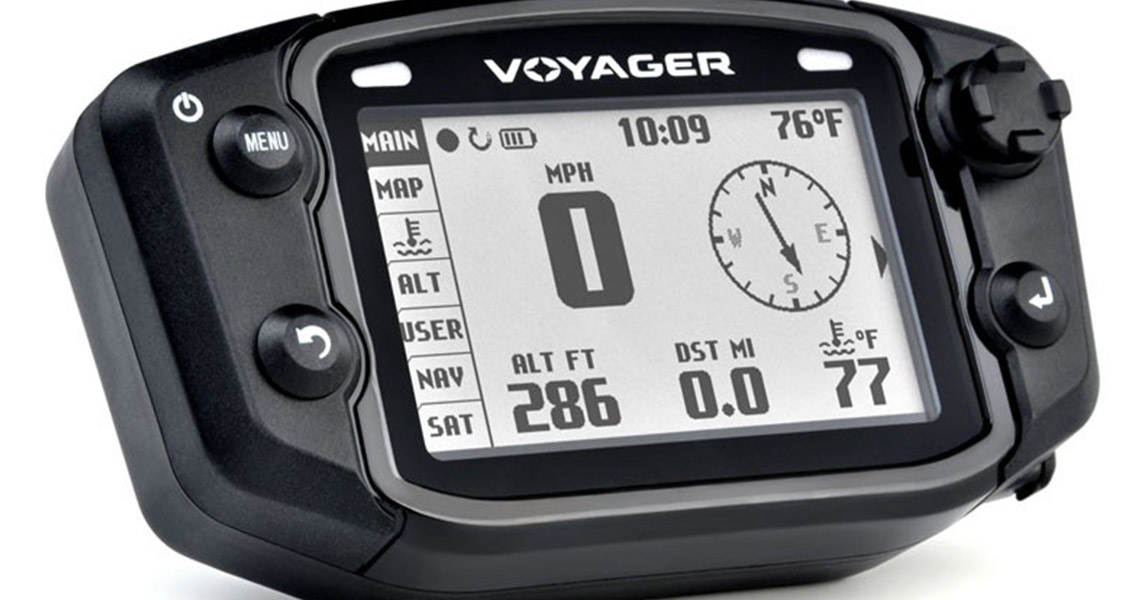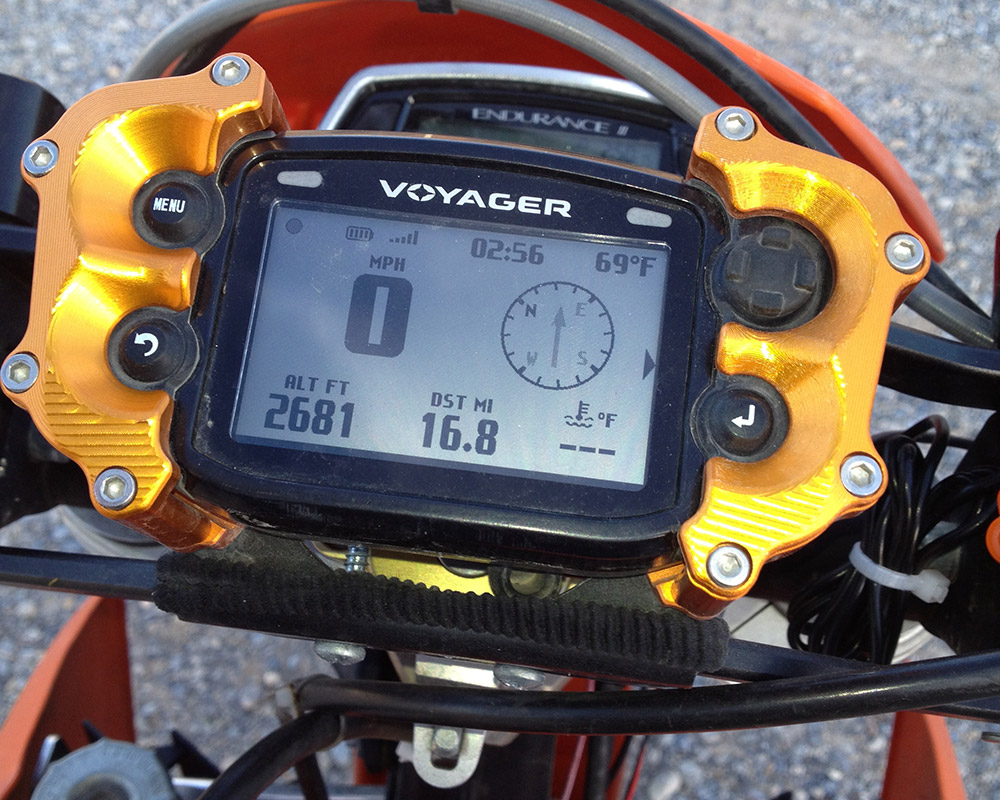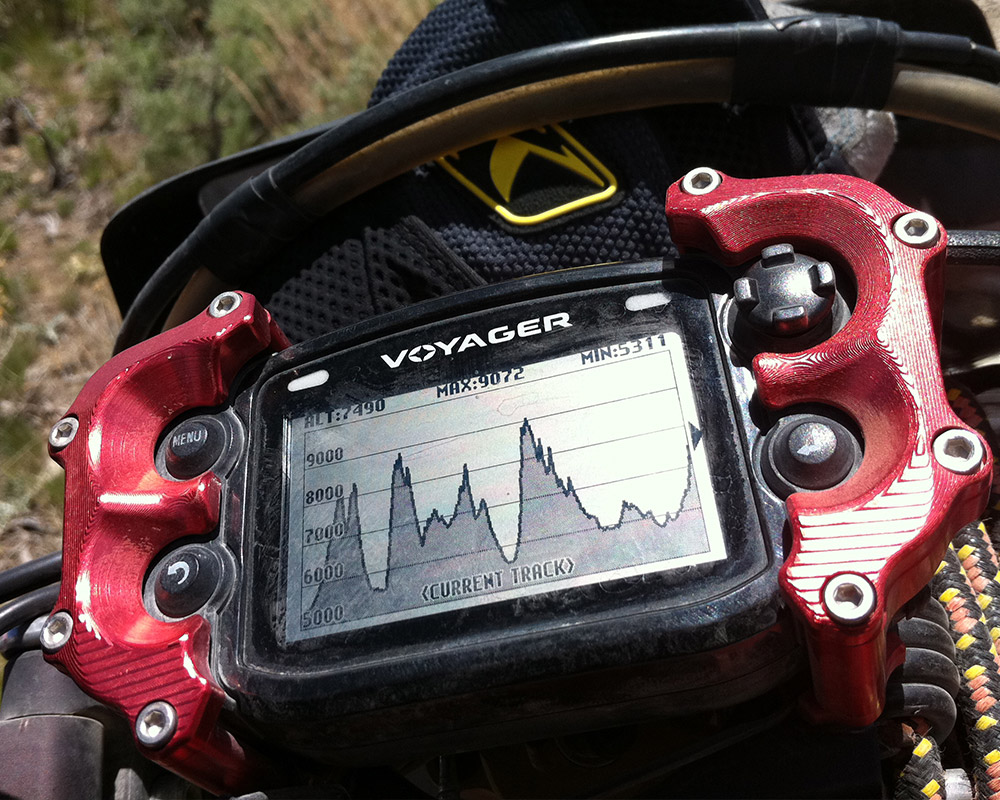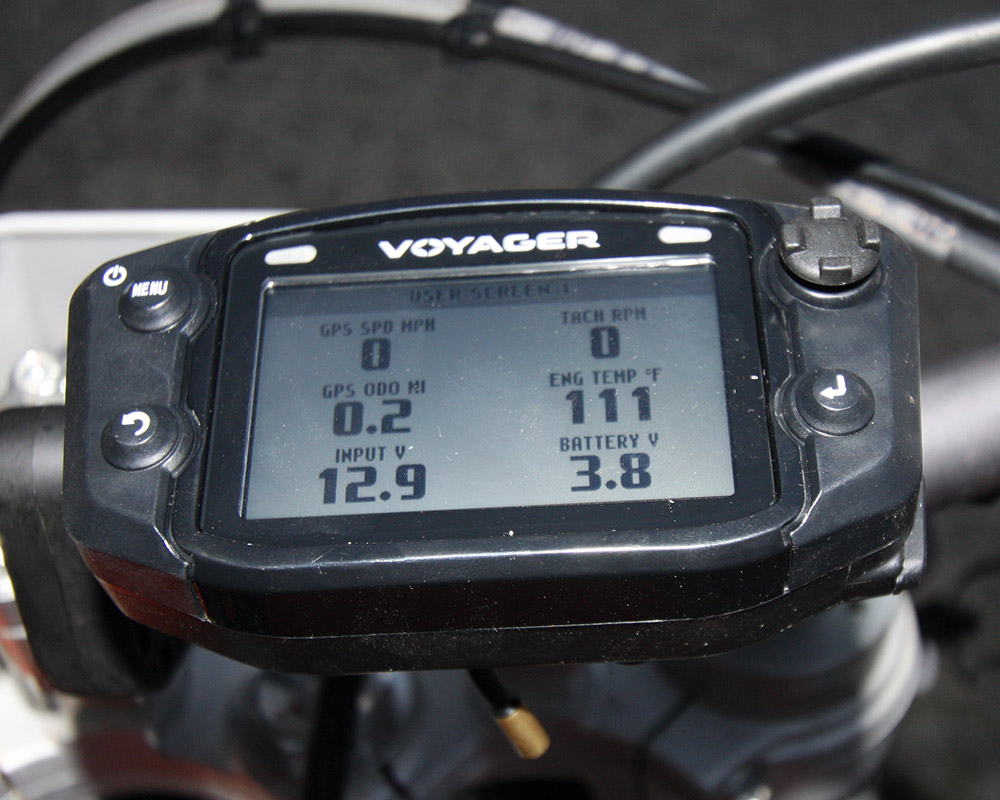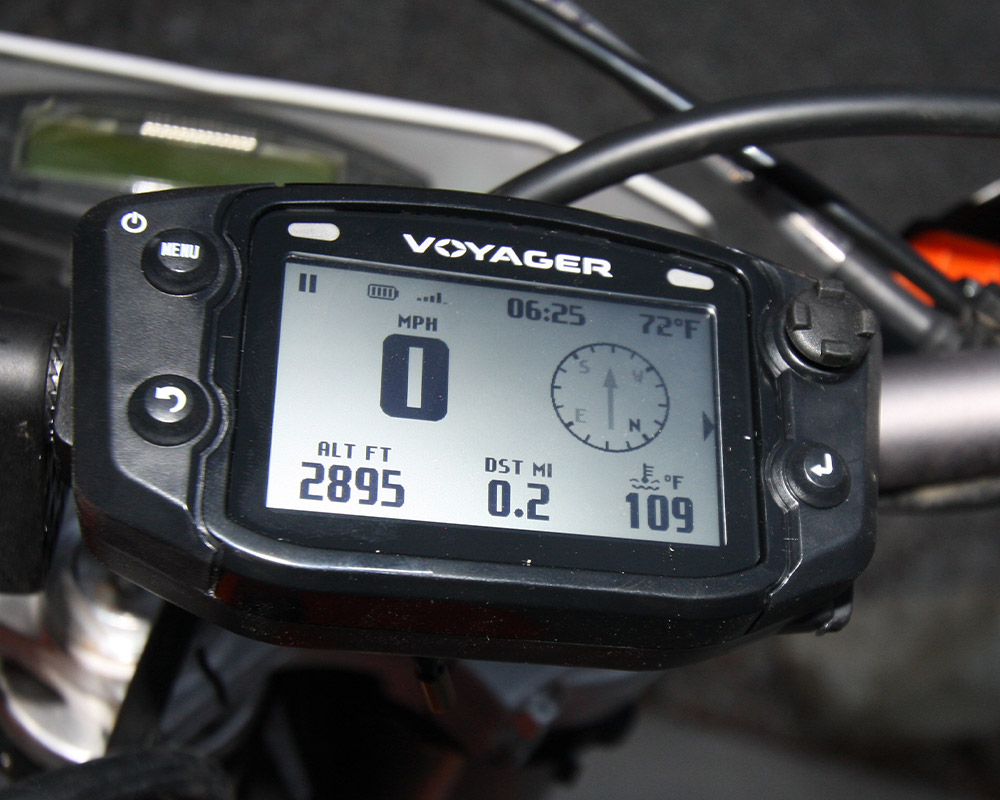Trail Tech Voyager GPS Kit
Company: Trail Tech
Price: $289.95
- Voyager gives you the confidence to explore new trails, record your own trail systems or even find ones that others have posted on sites like ohvtrails.net. If you don’t like a track or route, simply delete it from your device.
- Very easy to read display in the brightest of sunlight. Also has the ability to invert the screen to white on a black background for a better night time screen contrast through the backlight.
- Loading, creating and naming tracks, routes and waypoints right from your Voyager is a breeze. Anyone can do it!
- Ability to display only the tracks, routes or waypoints that you want on the map at a given time. You can change these settings quickly right from the ride settings.
- Freeways, city streets and fire roads don’t come loaded on the map. You would have to load them manually. Then again this isn’t your handheld unit meant for commuting.
- The stock mounting has nothing on the billet Voyager Protector. Take it from us, we learned the hard way.
- Screen size is a little small for some people’s vision.
- Trail Tech’s own Ride Leader software is great but does not work for a Mac. Adze and Adze Lite can be found in the App Store and serve as a good solution for Mac users.
What it is
- A motorcycle specific GPS with features and functions a off-road rider can use.
The Trail Tech Voyager is a magnificent global positioning system that allows you to build your own digital trail network, explore routes that others have laid out and then share those tracks and routes with your friends. It is a GPS unit designed for motorcycle trail riding that has many features, including providing the rider with location, speed (both GPS and off the wheel), distance, a compass, altitude, Temperature (ambient and of the bike), track logs and waypoints. It also detects the bike’s or battery’s voltage and rpm.
Trail Tech really designed the Voyager specifically for the off-road rider so it is very simple in some ways but complex in others. The 6.1 ounce, 4.5 x 2.5 X 1.1" (113 x 62 x 28.2mm) unit mounts with an included bar clamp mount and all the sensors and wires you need to attach the unit as much or as little as you want. If you leave stuff disconnected, it simply does not show up through the unit. The screen is a 240 X 400 grayscale LCD that is claimed to be fully readable in intense sunlight. Additionally Trail Tech makes bike specific kits so the sensors all match up with your machine. The unit has customizable screens and will run on its own battery power or off of the bike. It has a back-lit display for night use and there is excellent free software specifically for the Voyager that you can use to analyze your data and build tracks and routes for riding.
How it works
- Simple to learn and use interface.
- Lack of stored maps can be an issue, but you can make the maps you need.
- Huge amount of data storage and litterally unlimited by combining the use of the micro-SD card.
Mounting of the Voyager went very smooth, especially with the help of well made instructions. We used the $19.95 KTM specific tripleclamp mount. What caught my attention right off the bat during the install was that I didn’t need to do any hard wiring or splicing, the unit was ready to go with electrical plugs that fit perfectly to my machine, which is common on KTM applications. The only extra rigging needed was heating up my plastic front number plate to cut a slot for the less than bulky unit to sit in, but it would sit behind a headlight shell.
The Voyager is a simple unit with many features that really takes a long time to get the most out of it because it does so much. In its simplest form as a GPS unit, the Voyager allows you to create your own “tracks” when riding by recording where you have been. You can also upload routes or tracks (technically it is the same .gpx file data but the color of the line, grey or black, distinguishes if it was uploaded as a track or a route) and then use them to navigate on your ride by following the “cookie crumbs,” in GPS nerd speak. You have two map screens to navigate with and can easily toggle back and forth while on the fly. Both maps can be set and offer the option of setting either screen at different zoom or altitude views, with the centered location view or a fixed view. It is very easy to follow the tracks on the bike, especially with the orientation set at “track up” as that keeps the way you want to go right in front of you no matter the direction you are pointed, you are on the line if you are going the right way.
You can easily scroll around on your map screen and look to see where you are in relation to other tracks you have created or loaded, but here is the one major downfall when comparing the Trail Tech GPS to almost any other. There is no base map or street map data built into the Voyager. In fact if you don’t put a track log or route into the unit, it just does not exist. There is no topo data and the same for streams, rivers and lakes. Just the trails and roads you load in. This can be looked at as a positive (it keeps it simple) or a negative (very limiting for some.)
The Trail Tech Voyager isn’t like your smart phone’s map app, think of it as a blank canvas where your dirt bike is the pencil. Or you can do the drawing on the computer and drop the information, via a Micro SD card, right into the Voyager. It has a lot of built in memory to store tracks locally on the device, and then you can use the card to upload and download as needed during a ride. Information can be shared in seconds between Voyager units by using the card. Updates to software from Trail Tech are just as easy to keep the unit with the newest version. The Voyager accepts the MicroSD card very similar to a GoPro but with a rubber cap enclosing the port.
Aside from being a fully functional GPS system, you also have multiple other capabilities like running a wheel sensor for more (or less compared to GPS, depending on coverage) precise speed and distance measurement. The radiator temperature or air-cooled temperature sensor keep tabs on the bike’s heat and that data is logged based on your location as well. Same goes for altitude. The interesting thing that can be shown on graphing screens on the unit as well as in Ride Leader software, is how hot your bike was based on where it was. The main screen on the Voyager also has a graphical tachometer to show your rpm, which may surprise you, both on how little or how much you rev your bike and where you are making power. These features are definitely a plus if you enjoy geeking out on data, like being able to see how your bike runs based on the tightness or elevation of the trail.
The customizable user screens allow you to see data like your bikes voltage or the max speed and average speed. There are six spots on each of the two screens to customize your info. You can compare GPS speed and wheel speed, for instance. Additionally you can set the red and yellow warning LED lights to flash and then stay on at different temperatures alerting you of overheating issues.
Scrolling or switching screens while riding is simple and with only three buttons and a joystick/toggle button it does not take long to learn the steps. As you ride with the unit you will begin to appreciate both map screens, setting one zoomed out for highspeed and the second zoomed in for technical trails and following the line (see attached video). There are many ways to set them, and being easy to do so, it won’t take you long to find your desired setup.
The menus are simple to use and make setting up the unit easy, even without referring to the instructions. Yet the small size of the unit again has advantages of not interfering with space or weight but it can also be hard for some sight challenged riders to see the smaller numbers. Keeping the arrow on the track was easy for anyone who used the unit. And the screen does not glare like some GPS units, you can see it day or night as it is back-lit.
You will never feel any extra weight of the Voyager on the trails or even at the moto track, if your bike is a crossover like the KTM 300 XC we tested the unit on. After putting in motos at the local tracks, jumping 150 foot plus jumps in the dunes and tipping it over occasionally on the trail my standard mounted unit never showed signs of falling off. I had checked the mounting bolts for the sake of this test but I didn’t need to. Not once did they show signs of loosening up.
But in the end (for one of our units) we highly recommend that you invest in the additional protection for the Voyager with the billet aluminum Multiple Mount Protector ($109.95). Because as small as the unit is if your bike goes tumbling the Voyager is after all just made of plastic and glass.
At just shy of $300 you are getting a lot of information as well as a solid GPS device that will tell you where you are, where you’ve been and possibly where to go (if you have good track logs loaded.) There isn’t anything like it and for real trail riding it is much better than any non-motorcycle GPS.
Help support this site by purchasing through this link:
Rider Opinions
Leave a Reply
